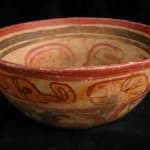Copador Style Mayan Polychrome Bowl, 300 CE - 900 CE
Terracotta
7.875 x 3.25
PF.5652
Further images
The exterior of this vessel is divided into two bands. The upper band is a series of glyphs repeated six times. This glyph takes the form of a head with...
The exterior of this vessel is divided into two bands. The upper band is a series of glyphs repeated six times. This glyph takes the form of a head with a long extended snout that leads to a hooked appendage. One glyph of a swirling wave breaks up the monotony of the six others. The lower band depicts two contorted and elongated figure squeezed into the narrow space. Stretched out along the bottom, these emaciated “swimmers” appear to support the upper glyphs with their hands and feet. They both wear a black and red oval shape adorned with wings above their torsos. Might these figures be gods or shaman supporting the message inscribed above them? The interior of the bowl has also been painted. The lip of the vessel has been painted red leading to two black bands inside. There, on the main body of the interior, the swirling wave glyph is repeated three times attached to another glyph resembling a stylized letter “E.” A black circle surrounded by a thin red star-shaped line that is bordered by another black band adorns the bottom of the bowl. Altogether, the interior and exterior decoration of this vessel is a very precise and significant symbolic language. Unfortunately, the vocabulary has been lost to us. However, the beauty of this pictorial statement can still be easily appreciated.









